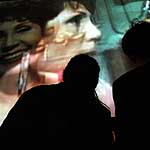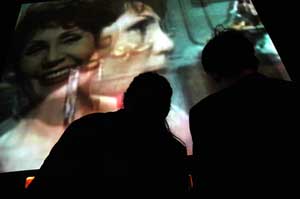
The San Antonio new media duumvirate better known as Potter-Belmar Laboratories took a moment to talk to me about new media in TX. Leslie Raymond, head of the new media program at the University of Texas (UT) at Austin, and sound connoisseur Jason Jay Stevens started their collaborative video and sound experiments back in Michigan years ago. The married artists moved their headquarters to San Antonio after Leslie took an offer from UT San Antonio to start its new media program. Since then, Potter Belmar Labs has slowly acclimated to Texas flora and fauna. The couple bought a voluminous warehouse near the abandoned Lone Star Brewery in South San Antonio. Their style of appropriating archival footage, video clips and manipulated soundscapes constantly challenges viewers to reexamine familiar images. I met with Jason and Leslie at their warehouse a few weeks ago to talk about recent projects. Part of the interview was conducted online to update recent show information.
Michelle Valdez: How would you describe Potter Belmar Labs to someone who knows nothing about your work?
Leslie Raymond: Although we have worked in multimedia installation art
and multimedia sculpture, the core of our work over the last five years
has been what is most often referred to as “live cinema.”
MV: Can you give me some feedback on your most recent show in New York?
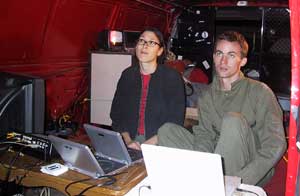
Jason Jay Stevens: We performed for three to four hours following
sunset each evening, from Monday, [September] 3rd, through Friday, the
7th. Lexington and 47th is a very busy corner in Midtown Manhattan.
The sidewalks are always full of people. When our sets started, our
audience was mostly folks determined to get home or to appointments
after work. But for the last couple of hours each night, we were
providing spectacle for in-between bar-hoppers.
We received submissions in the form of little pieces of stories from
friends around the country, via email and mail, and directly from New
Yorkers, especially people staying at the Roger Smith Hotel . These
became title cards that were projected, big and luminous, on one-third
of the Lab’s window space (it’s a corner lot, fishbowl gallery). Whether or not any contributing “author” was present during our
performances to witness our interpretation of his or her particular
submission, we cannot say, but we used the various
submissions/suggestions to inspire the “plot,” that is, the content of
the video projected onto the other two-thirds of the gallery window
space, as well as the back wall, and the audio coming from speakers
inside and outside the gallery.
LR: I would add that these suggestions in this context provided more
of a tone or trigger for us to create a particular “environment”
through sound and image. When using this technique with a sit-down
audience (Salon Mijangos, San Antonio; Sound Art Space, Laredo), we
would arrange the “intertitles” (suggestions) into some kind of
narrative arc before sitting down at our gear to play. They provided a
skeletal system on which to improvise. In the case of the New York
show, our audience was not captive, [so] was not to be led through a
sequence of sound-image events, and as a result our performances became
much more ambient, something one could catch in a short glimpse or hang
around for an hour and witness a slow development.
One of the most exciting things to me was seeing people standing
outside watching us, and then talking excitedly on their cellphones to
someone, describing what they were experiencing. There were also a few
instances of people catching our eye, smiling and giving the thumbs-up
sign — and in one case a guy actually took the time to write us a note
that said, “GREAT WORK!” and held it up to the window for us to see.
How wonderful!
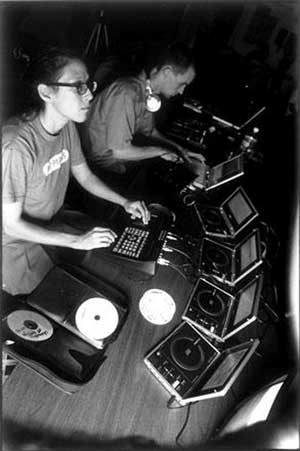
The way we set up at the Lab was also an artwork in itself — it wasn’t
a straight projection, but a two-projector installation… We hung
rear-screen projection material on the huge plate-glass windows lining
both Lexington and 47th, with open strips through which people could
look in and see us. One projection was onto those windows, and the
other was on the long wall inside the Lab. They both showed the same
thing, but this provided multiple viewing possibilities — on the
windows, the image was divided into two major sections, cropped views
of the original image, which was shown in its entirety on the back
wall. At the right angles, one could see the back image interacting
with the images on the windows, which was yet another completely
different way to experience the piece. The sound was coming out of
speakers mounted on the outside of the building. There was actually a
third projection, of the intertitle cards that people submitted to us,
which we shot digital stills of and burned to a DVD. An opaque
projector would have been perfect for this projection, but it was
amazingly impossible to find a rental company who had one. These were
projected onto the window as well, just a little further [along 47th]
down from the imagery.
I’d also add that I was mixing in video imagery that I was shooting in
the city, and some stuff from that street corner where we were
performing. This was a very interesting aspect to the show that I
would develop even further, given more time and resources — to take
some of those suggestions/intertitles and shoot based on those, and get
people involved in maybe acting out some responses, and working THAT
into the mix. Midtown is pretty devoid of the whole art scene, and
what we were doing completely punctured the scene there.
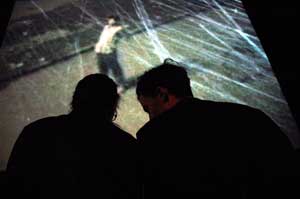
MV: What do you think is going on in new media as far as the
contemporary art scene, both locally and nationally? Give some of your
own impressions of the media and where you see them fitting into the
picture. Do you see any trends? Do you feel like you have other
contemporaries, or that maybe you’re ahead of the curve here?
LR: From where I’m standing, I see [in the contemporary art scene in
San Antonio] that there are a handful of artists who work in many
media, and video might be one of them. Michele Monseau and Chris Sauter
are two people who immediately come to mind. Then there are people like
Karen Mahaffy, who is primarily a video artist but doing more
gallery-based work. John Mata is also another person who works in
everything and uses video as well. I haven’t seen a lot of new
technology work here.
JJS: We’re definitely ahead of the curve when we think of ourselves in
terms of our roots. You mentioned San Francisco, and in a way we belong
in San Francisco because everything we do is sample-based and remixed.
LR: That’s the mecca.
JJS: And even the San Francisco aesthetic, we kind of fall into that. I
talked to some San Francisco folks recently, and they assured me there
are all kinds of people doing this kind of work. Still, I have yet to
see anybody doing what we do in Texas. Especially in terms of cinema,
because there are DJs and VJs all over the place and that’s almost as
common as gin and tonics in the bar scene.
LR: I’m really interested in what’s going on in Dallas and Houston, but we haven’t explored those scenes yet.
MV: Why are you so interested in those scenes?
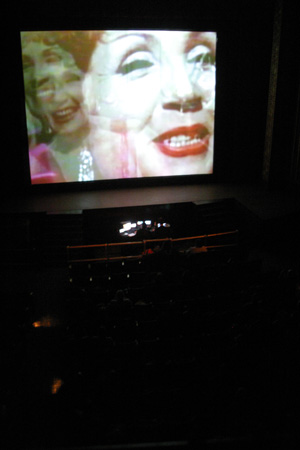
LR: I’m interested in Dallas and Houston because they are nearby. I
still don’t know a lot about what is happening, but Aurora Picture Show
is in Houston — and they are a very well-respected experimental moving
image center that showcases avant-garde/artist-made film and video, and
even brings in “live cinema” performers. “Live cinema” seems to be one
of the more used terms to describe what Jason and I do.
Andrea Grover, the founder of Aurora, is teaching a class this term on
participation art at the University of Houston. Participatory art is a
fascinating area, hardly new (look into the surrealists and Fluxus for
starters), but heavily influenced now by the internet, text messaging
and other contemporary communications media.
Aurora has recently started its own library of moving image material —
it happens to be located right next door to Patrick Kwiatowski in that
bizarre Menil neighborhood. Patrick is part of Microcinema — a DVD
distributor for avant-garde/artist-made (and other) moving image work,
which evolved from Blackchair Cinema, which was started by Joel Bachar
over a decade ago in Seattle. I became involved with that scene when
Joel picked up my optically printed 16mm film Rife W/ Fire, an
experimental documentary about pyrotechnic artist Steven Rife, who I
became friends with when I lived in St. Paul. I completed that film in
1995 and Blackchair/Microcinema showed it all over the world. They are
part of the “new media scene” (although film and video are hardly new
anymore) in that they helped explode this whole movement of
microcinemas.
As for Dallas, I know that there is a pretty big art and technology
department at UT Dallas . That’s pretty exciting to me, though I know
very little about it — other than artists and engineers are
collaborating, they have a virtual gallery set up in Second Life, and
Dean Terry is doing some interesting [exhibitions] and other projects
there. There is also And/Or Gallery that Paul Slocum runs —
don’t know too much about that either, but have seen a little bit of
Paul’s artwork and am glad that he’s in Texas to help blaze the new
media trail.
I would also add that there is a transmedia program at UT Austin. I
have seen the work of people like Luke Savisky and Murry McMillan (now
collaborating with his partner Megan McMillan) who studied there — they
are out there and making great work!
Seems like everywhere I go around here, people are like, wow, I’ve never seen anything like what you are doing!
JJS: With improvised cinema, we are identifying a common zeitgeist by
collecting a little bit of wit from anybody who’s game to contribute. Wikipedia is a representation of global consensus on all things
factual, established also by anybody and everybody with a little time
and will to contribute.
That’s an interesting comparison, considering our next single-channel work may be a kind of poetic encyclopedia.
An iPhone with the ability to access Google and Wikipedia satisfies a
centuries-long arc of development in the technology that aggregates and
disseminates global consensus. One website connects you to everybody’s
advice and all the perspectives on every issue (albeit ranked to their
scheme, tsk); the other presents an ever-changing and yet egalitarian
consensus report (the resolution of which is increasing exponentially,
by the way). And you can talk to anybody on earth at anytime,
anywhere, on the same little device.
The noosphere is physically realized, fully accessible. Scholarship is
liberated from the library table. The distribution of reproducible
culture is flattened out. Trivia is more trivial; knowledge is way
cheaper, familiarity just a few moments away.
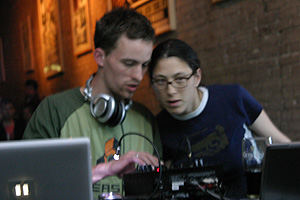
MV: I recently watched a biography of Jacques Derrida and I wrote down
a lot of quotes that were relevant to my own artwork. You need to
introduce your own artwork here, because some people might not know
exactly what it is. I emailed Jason and said I wanted to talk to you
guys about The Future, and then I found this funny quote from Derrida
that says, “Prepare yourself to experience the future and welcome the
monster.” You did mention deconstruction earlier, and so I was
thinking, what do you think about this quote? Are you always thinking
about the future?
LR: I’m not exactly sure what he means by “the monster,” but I feel
like it’s really here. And as far as thinking about the future, my VJ
name is Future Worker Girl and my motto is, “Working for a better
tomorrow today.” I always feel like the more I can sort of amplify
positivity, whatever little steps I can take in my life or through my
work are hopefully going to have positive implications for tomorrow and
so on.
JJS: I guess by chance, I don’t think of it as the future. This is
really weird and sounds pompous to say, but I feel like a lot of my
life I learned about things like, “Oh, that finally happened, it really
came true.” My guess, in that quote from Derrida, from a
deconstructionist point of view, the monster is the unknown and it
instills fear. If you break it down into the smallest components, it’s
this unknown that he’s talking about in being prepared for the future.
It’s the unknown and it’s scary; the future is always scary.
MV: In that quote, he’s talking about normalcy, and a monstrosity
reminds us what is normal — for example, a human face and what you
expect to find in a human face. I just really liked that quote. I think
what you’re doing is avant-garde, for Texas and maybe even the rest of
the country. If you’re already on the cusp of the next thing [new
media], there’s still this question of the future. What could new media
be after this?
JJS: Well, maybe this will be one of those things like I said before,
“Oh, wow, that finally happened…” There’s this very comforting
feeling that it was only 120 years ago when musicians… the best you
could do was go down to the street corner and strum and set your hat
down. You get a gig, but before the first records. It’s like we’re
coming back around to that. The playing field is leveled with YouTube
and the internet. Maybe the 20th century was the anomaly. Maybe we’re
not heading into an anomaly; we’re heading out of an anomaly.
MV: What are your thoughts on modern cultural phenomena like YouTube and internet-based art? What does it all mean for artists?
LR: One of the most powerful aspects of the internet is that it gives
people a truly democratic platform from which to express themselves, to
write or to post images and instantaneously share these with thousands
of other people. There is also lots of room to engage in critical
dialogue, to be able to critique our public leaders and to suggest
alternate solutions, etc., in word or image. Bloggers are not
constrained by the commercial interests of the old media, where you
have, for example, a company like Monsanto putting the pressure on Fox
News to kill an investigative report revealing the harmful effects of
their product rGBH. Because of the large financial relationship the
two companies share in terms of advertising dollars, Fox was forced to
try all kinds of methods to shut the reporters up. I won’t go into all
of the details, but just want to make the point that the internet is a
very interesting place right now, especially in terms of the kind of
debate that can exist. [See the film The Corporation and the book Free
Culture by Lawrence Lessig.]
MV: In conclusion, I recently read somewhere that the definition of
avant-garde could simply be “those artists who have the most energy.”
Do you agree? Is Potter Belmar Labs a catalyst for new media? How will
your collaboration echo into the Texas art ether?
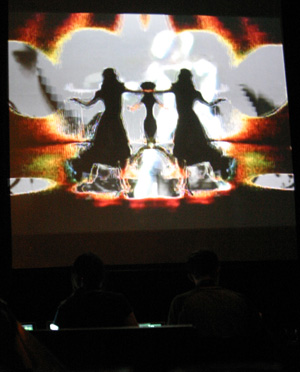
LR: To me, the avant-garde is about being tuned into and responsive to
the zeitgeist. Using contemporary media is an extension of zeitgeist,
but maybe you don’t have to use computers to be avant-garde nowadays.
You could be someone like Howard Finster — an artist with lots of
energy, inspired by the good lord to paint thousands of paintings. He
wasn’t avant-garde; he was a folk artist. And that does not diminish
the quality of his work, nor the amount of respect I have for him one
bit. Also, it seems useful to mention that new media does not
necessarily equal avant-garde.
Are we a catalyst for new media? I hope so. My mission in San Antonio
is to start a new media program at UTSA. My students are pretty
excited to work in new media and video, and that enthusiasm will
spread, especially when they get out of school and continue making
their work. I’m trying to contribute in the community as well by
opening up to the public educational system film and video screenings
that I organize for my classes. The community can stand to have more
understanding and context of where new media art is coming from. I
might add that video is hardly a new media.
I’m also on the board of the Artists Foundation of San Antonio, so I
hope to be able to positively influence that organization to understand
more about media art in general. Media art is one of the least
understood art forms — even by media artists themselves. I just read a
report put out by Rand called “From Celluloid to Cyberspace” about the
development of the field, and a major survey of the scene from the
perspective of granting agencies. There is a lot of confusion and very
little hard data on artists, audience, funding, etc.
How will our collaboration echo into the Texas art ether? Hard to say
— we gotta get some gigs! It takes a lot of time and energy to chase
those down — we need a manager or promoter or handler. But eventually,
new media art will be here… it’s only a matter of time. Texas seems
slightly behind the curve — I don’t know why. In San Antonio it may be
due to economics. It is only natural for artists to adopt and play
with new technologies, and the further they become embedded in the
culture, the more access and interest artists will have.
JJS: I thought by calling something “avant-garde,” it meant you’re not really sure if you like it.
LR: What PBL does is an extension of the whole long history of art — from Lascaux onwards.
JJS: …the magic lantern shows that existed for centuries, leading up
to the invention of motion film. Experimental film, stretching back to
innovators like Mary Ellen Butte, as well as the expanded cinema
experiments of the 1960s, including the psychedelic light shows put on
by such groups as the Joshua Light Show. [Dude!]
LR: Art is a dialogue that builds upon itself, responds to the current
time and is interwoven with culture, society, politics, fashion, etc.,
telling and retelling the story of human experience.
JJS: The economy of culture is convulsing. The role of the artist has
been in flux for a century already and it won’t settle for a while.
(LR: If ever) Riding this current, an artist, as an entrepreneur,
focuses on labor as a creative force and on art as a uniting force
[with] experiment as a necessary means of exploration.
Images courtesy the artists
Michelle Gonzalez-Valdez is an artist and writer currently living in San Antonio. She also performs under the name Bunnyphonic and has a blog about art in SA.




